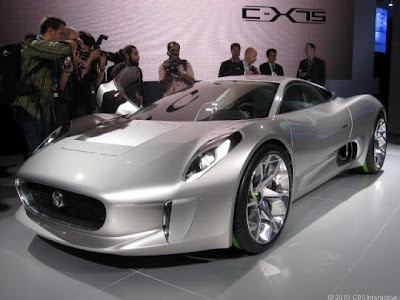Jaguar C-X75 concept as a hybrid supercar

Jaguar C-X75 concept .In concept form, the C-X75’s 188-horsepower gas engine charged a battery pack, which in turn spun four 195-horsepower electric motors, one at each wheel. Because development is ongoing, Jaguar did not reveal output numbers for the production car’s gas-electric powertrain.
Whereas Jaguar estimated the concept car’s purely electric range at 68 miles, the figure has been detuned to roughly 31 miles for production.
Williams F1, the Formula One racing program, is being retained by Jaguar to assist in development of the car’s carbon-fiber monocoque chassis, aerodynamics and hybrid system. Williams F1 also announced the appointment of Paul Newsome, a former Jaguar Land Rover engineer, to lead the joint-development project from Williams’ headquarters in Grove, England.
Jaguar announced today that it will produce the drop-dead gorgeous C-X75 concept car as a hybrid supercar with a turbo gas engine and two electric motors. Jag says the sports car will rocket from 0-60 mph in under 3 seconds.
It will be all-wheel drive and with an electric motor on each axle we'd except that to allow performance torque vectoring.
"We were always determined that the Jaguar C-X75 would be as striking on the road as it was in concept form," said Jaguar's master designer Ian Callum. The car, to be developed with Williams F1 racing engineers and built in Britain, will carry over the concept's light, all-carbon-fiber construction.
"The C-X75 received an incredible reception as a concept car," said a statement from Adrian Hallmark, Jaguar brand director. The production car will not have that cool pair of little turbine engines under the backlight of the concept that could generate electricity and move the car. Jag is going with an internal combustion engine in the interest of getting the car to market in a reasonable time.
Jaguar's C-X75 concept was the most stunning car unveiled at the 2010 Paris motor show. Now Jaguar says it will build a limited production run of 250 vehicles.
We often see concept cars at auto shows and wish the automakers would actually build them. Jaguar will work with Williams F1, a racing team, to develop a carbon fiber chassis for the car.
The concept featured electric motors at each wheel, a power-train design Jaguar will keep. Tata, Jaguar's parent company, is working with Bladon Jets to develop microturbines for use in cars, but that technology is not ready for prime time.
Those microturbines looked very cool under the car's back glass, and the engine generator won't have nearly the same visual impact.
